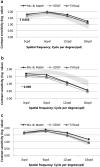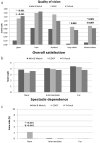Comparing the visual outcome, visual quality, and satisfaction among three types of multi-focal intraocular lenses
- PMID: 32908159
- PMCID: PMC7481789
- DOI: 10.1038/s41598-020-69318-y
Comparing the visual outcome, visual quality, and satisfaction among three types of multi-focal intraocular lenses
Erratum in
-
Author Correction: Comparing the visual outcome, visual quality, and satisfaction among three types of multi-focal intraocular lenses.Sci Rep. 2021 May 3;11(1):9776. doi: 10.1038/s41598-021-88753-z. Sci Rep. 2021. PMID: 33941797 Free PMC article. No abstract available.
Abstract
This study compared the visual outcome, visual quality, and satisfaction following implantation of the Mix-and-Match bifocal IOLs (+ 2.75 D and + 3.25 D add power Tecnis Multifocal Model), EDOF IOL (Tecnis Symfony IOL), and Trifocal IOL (FineVision PodFT, PhysIOL). All outcomes were compared among the three groups. The manifest refraction indicated that the EDOF group had significantly higher myopic spherical equivalent values than did the others. In the terms of visual acuity, there were no significant differences in far or intermediate visual acuity among the three groups. Only in near (33 cm), the EDOF group had significantly worse binocular visual acuity than did the Trifocal group (p = 0.002). Regarding to defocus curve, the Trifocal group had better defocus curves at near distances (- 2.0 to - 3.5 D; p = 0.001 vs. EDOF) than did the other two groups. In contrast sensitivity test, the EDOF group had relatively lower value than did the other two groups. In reading speed, only at 0.3 logMAR (6.5-point font), Mix-and-Match group had a significantly higher reading speed than did the other two groups (p = < 0.001 vs. EDOF, p = 0.007 vs. Trifocal). also Mix-and-Match group showed significantly fewer visual artifacts. There were no differences between the three groups in terms of patient satisfaction.ClinicalTrials.gov number: NCT04019691.
Conflict of interest statement
The authors declare no competing interests.
Figures






References
Publication types
MeSH terms
Associated data
LinkOut - more resources
Full Text Sources
Medical

